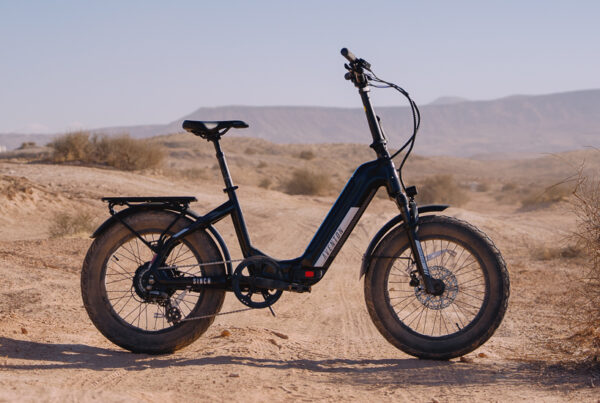Our Range Test is a method for evaluating battery performance, but it also allows us to get an idea of the efficiency of a bike’s motor/battery pairing. Additionally, it gives us a bracket of real-world distance measurements that we can compare to manufacturer’s claims. We give a brief description of how we perform this test in the graphic above.
Previously, I mentioned our skepticism regarding Himiway’s claims that the Cobra Pro could reach 60-80 miles on a single charge. This was primarily because of the bike’s 1000W motor (which we assumed was a power-hungry beast), its substantial weight (an 88-lb frame is not uncommon, but it’s still a lot of bike for the motor to move in addition to a rider), and the fact that it uses the same size battery as the standard Cobra – a fully-integrated 48V, 20 Ah (or 960 Wh) battery with Samsung/LG cells.
Regarding Himiway’s advertised range, I was happy to learn that they performed their own range test on the Cobra Pro under thoroughly documented conditions. According to our contact, their test was performed on a flat road, with light wind, a temperature of around 77°F, a roughly 132-lb rider, and a speed of about 15 miles per hour.
In our test, the Cobra Pro succeeded in meeting Himiway’s claims, though there are a few caveats to examine in relation to our data. Considering the bike’s two modes, we performed range tests at the two extreme ends of the spectrum – with maximum assistance in Sport Mode / PAS 5, and with minimum assistance in Eco Mode / PAS 1. These trials were also primarily held on paved multi-use paths with a 20 mph speed limit, so we reduced the Cobra Pro’s top speed to adhere to this regulation. With the bike in its standard settings, its range data may have been different. Again – with its 1000W motor, this bike is meant for off-road use, so our test environment is likely to be different from the areas consumers will use it.
With maximum assistance, we saw a range of roughly 42.5 miles, and with minimum assistance, we reached just over 64 miles. This was impressive, but there are a few more considerations to take into account here.
The Cobra Pro’s battery capacity is admittedly gigantic – when looking at previous e-bikes we have tested, it’s among the highest we have seen without getting into dual-battery territory. It also features unique technology that Himiway provided some detailed technical information on. Without getting lost in the weeds, just know that the cells that make up the Cobra Pro’s battery are larger than standard cells in both diameter and length, giving them a significantly higher capacity. Their chemical composition also allows them up to 20% higher energy density than standard cells, allowing for a smaller battery but a larger capacity.
Of course, the Cobra Pro’s high-capacity battery powers its Bafang 1000W motor that I mentioned earlier. This motor likely does wonders to increase the bike’s efficiency (and therefore its range) thanks to the fact that it is a mid-drive instead of a hub motor. Due to their positioning within the bottom bracket, mid-drive motors naturally split the work needed to move a bike with its rider. This requires less energy to be drawn from the battery, allowing it to last longer – and move the bike across a greater distance before running out of charge. So – while the Cobra Pro’s motor is extremely powerful, it makes for a more efficient pairing with its battery than the standard Cobra.
This is a good time to bring up a feature of the Cobra Pro’s motor that likely skewed our test results to some degree. We noticed during our range test in Sport Mode / PAS 5 that, after going only about 21 miles, the motor’s power dropped significantly when the battery hit 25%. At this point, the display read only about 375W in motor output, and climbing hills suddenly became much more difficult. Despite feeling this unusual drop-off, we continued and finished our range test, then reached out to Himiway later to determine what had happened.
We learned that the Bafang motor has an overheat protection feature that limits its torque output when activated. This kicks on when the motor overheats from working hard and drawing a large amount of current from the battery. The fact that the motor HAS this feature is excellent – it prevents the motor from heating up to the point that it sustains damage and/or fails – even if it resulted in our max PAS distance getting stretched out by a few miles.
This feature seems to encourage the full use of all of the Cobra Pro’s settings to match its environment. Considering how functional the bike is on rough terrain even in lower PAS settings, it seems best to keep it set at a low-to-mid level most of the time. Bumping its power level up to a high PAS setting only when it is truly needed, and reducing it again when it is not, should help to prevent the motor from overheating.
Source link








